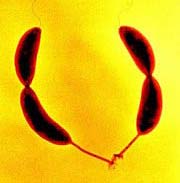 |
Caulobacter crescentus is the best adhesive organism found in nature. (Image: Nature) |
The gecko, clam, and oyster must now step aside, as physicists have discovered the owner of the toughest adhesive in the biological world, the bacterium Caulobacter crescentus, known for its ability to cling to river rocks.
Caulobacter crescentus is often the first organism to inhabit any water surface, from ship hulls, rivers, streams, to water pipes and urinary tract tubes. It is renowned for its remarkable ability to resist strong currents and remain stationary.
The adhesive produced by Caulobacter crescentus can adhere to a surface even under a pulling force equivalent to four cars placed on a coin.
Specifically, it can withstand a pulling force of up to 70 newtons per square millimeter, while commercially available super adhesives break under forces of 18-28 newtons per square millimeter.
Now, scientists are attempting to unravel the mystery of how this material is made. They have discovered that the adhesive is composed of long-chain sugar molecules known as polysaccharides. The precise mechanism of how this adhesive functions is still unclear, but researchers speculate that there must be some special proteins associated with these sugar molecules.
“We see clear applications because this adhesive works on wet surfaces</em," said Yves Brun, the lead researcher and microbiologist at Indiana University. "One possibility could be using it to develop biodegradable surgical adhesives.” Engineers could also utilize this super-adhesive.
However, “the challenge will be to produce the super-adhesive in large quantities without it sticking to anything used for its production,” Brun added.
T. An




















































